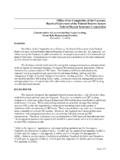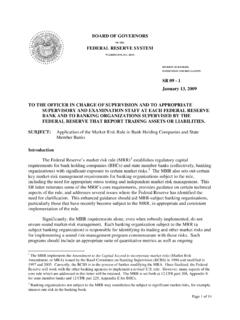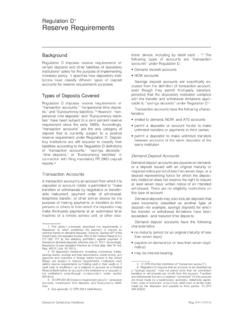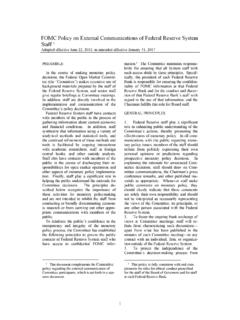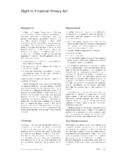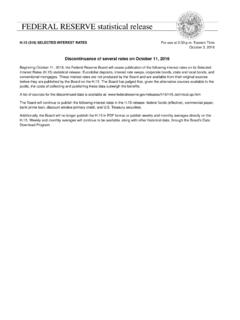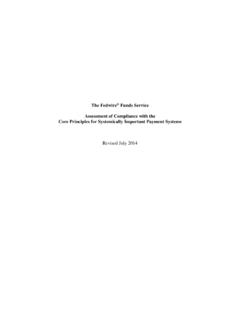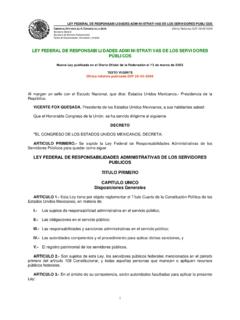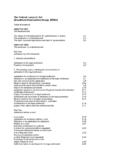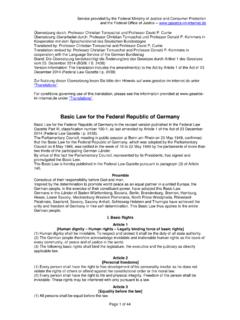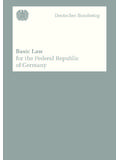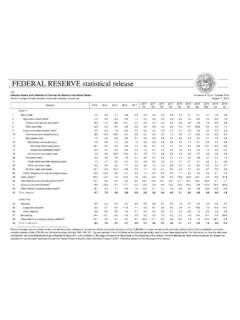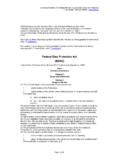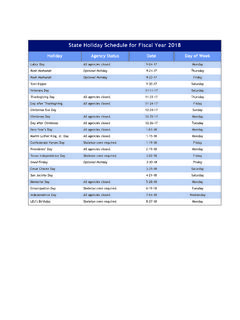Transcription of Federal Trade Commission Act Section 5: Unfair or ...
1 Federal Trade Commission ActSection 5: Unfair or Deceptive Acts or PracticesBackgroundSection 5(a) of the Federal Trade Commission Act(FTC Act) (15 USC 45) prohibits Unfair ordeceptive acts or practices in or affectingcommerce. This prohibition applies to all personsengaged in commerce, including banks. TheBoard has affirmed its authority under Section 8 ofthe Federal Deposit Insurance Act to takeappropriate action when Unfair or deceptive actsor practices (UDAP) are March 11, 2004, the Board and the FederalDeposit Insurance Corporation (FDIC) issued ajoint statement (Joint Statement) regarding theagencies responsibilities to enforce the prohibi-tions against Unfair or deceptive Trade practices asthey apply to state-chartered banks.
2 The JointStatement contains a discussion of managing risksrelating to UDAP and general guidance on mea-sures that state-chartered banks can take to avoidengaging in such acts or practices, including StandardsThe Joint Statement contained in appendix A ofthese procedures gives a complete description ofthe legal standards for both Unfair and deceptivepractices. The legal standards for unfairness anddeception are independent of each other. Depend-ing on the facts, a practice may be Unfair ,deceptive, or both. The legal standards for UDAPare briefly described PracticesAn act or practice is Unfair where it causes or is likely to cause substantial injury toconsumers; cannot be reasonably avoided by consumers.
3 And is not outweighed by countervailing benefits toconsumers or to policy, as established by statute, regula-tion, or judicial decisions may be considered withall other evidence in determining whether an act orpractice is PracticesAn act or practice is deceptive where a representation, omission, or practice misleadsor is likely to mislead the consumer; a consumer s interpretation of the representation,omission, or practice is considered reasonableunder the circumstances; and the misleading representation, omission, or prac-tice is of UDAP to Other Laws andRatingsSome acts or practices may violate both Section 5of the FTC Act and other Federal or state acts and practices may violate only the FTCAct while fully complying with other consumerprotection laws and regulations.
4 Therefore, if apotential UDAP violation is found, examinersshould consider whether other statutory or regula-tory violations have occurred. The Joint Statementspecifies laws that warrant particular attention inthis regard (see appendix A of these procedures).Furthermore, when illegal credit practices areidentified through a review of UDAP compliance,examiners should consider whether the illegalpractices adversely affect the Community Reinvest-ment Act rating of the institution pursuant to theregulatory requirements of 12 CFR (c).
5 Compliance Risk EvaluationUDAP violations can present significant legal,reputational, and compliance risks for risks highlight the need for examiners toassess compliance with Section 5 of the FTC Act inconjunction with consumer compliance examina-tions, other related supervisory activities, andconsumer complaint investigations. Consistent withthe Board s risk-focused consumer compliancesupervision program, compliance with Section 5 ofthe FTC Act should be considered when develop-ing risk assessments, scoping an examination, orwhen investigating a consumer determination of whether a particular act orpractice is Unfair or deceptive will depend on ananalysis of the facts and circumstances.
6 Althoughindividual violations or complaints may appearisolated, when considered in the context ofadditional information including other violations orcomplaints, they may raise potential UDAP Compliance HandbookFTC Act 1 (12/16)Furthermore, the prohibition against UDAP notonly applies to all products and services offered bybanks, but to every stage and activity, from productdevelopment to the creation and rollout of market-ing campaigns, and to servicing and , particular focus should be paid to newor modified systems or products and 5 of the FTC Act.
7 2 (12/16) FTC ActConsumer Compliance HandbookFederal Trade Commission Act Section 5 Examination Objectives and ProceduresEXAMINATION OBJECTIVES To determine the adequacy of the bank s internalprocedures, policies, and controls to ensureconsistent compliance with Section 5 of the FTCAct. To determine if the bank complies with Section 5of the FTC Act, which prohibits Unfair anddeceptive acts or PROCEDURESIn order to fulfill the examination objectives statedabove, and consistent with the Joint Statement,examiners should identify the bank s internalpolicies, procedures, and controls to be reviewedfor UDAP compliance.
8 In particular, the bank scompliance management systems; advertisingand promotional materials; initial and subsequentdisclosures; servicing and collections; and man-agement and monitoring of employees and thirdparties should be reviewed as they relate to theproducts and services identified as potentialareas of also should use these procedures inconjunction with the guidance and best practicescontained in the Joint Statement to determinewhether an Unfair or deceptive act or practice hasoccurred. Specifically, examiners should, as appro-priate review previous examinations reports, includingconsumer compliance, and safety and sound-ness examination reports; review current and prior examination findingsregarding the institution s involvement in acts orpractices that violate or may violate Section 5 ofthe FTC Act; review the bank s policies, procedures, andinternal controls.
9 Review a sample of consumer complaints, adver-tisements and promotional materials, disclo-sures, customer agreements, and third-partycontracts and instructions; interview management and staff about the bank sacts and practices; and discuss any examiner concerns with bank Compliance ManagementProgramsA bank s compliance management program shouldfocus on the avoidance of acts or practices that areunfair or deceptive and on the prompt correction ofany such identified acts of practices. The degree ofspecificity with which a compliance managementprogram should address this area will varydepending on the bank s size, complexity andproduct offerings.
10 A small bank that offers a limitednumber of products through a few branches maynot need the kind of specific, documentedcompliance program needed in a bank engagedin, for example, nationwide mortgage or credit to Evaluate1. Determine whether the bank s policies andprocedures include guidance on preventingunfair or deceptive acts or Ascertain whether the bank reviews its practicesin the context of Federal regulations, policies,and decisions on Unfair or deceptive acts Ascertain whether the bank s compliance man-agement function looks beyond the identificationof individual violations to determine if its prac-tices may be Unfair or Determine whether the bank trains its employeeson the provisions of the FTC Act that Determine whether the bank reviews consumercomplaints to identify potential compliance prob-lems and negative trends that have the potentialto be Unfair or deceptive.
